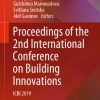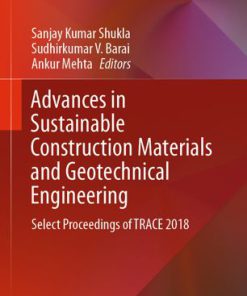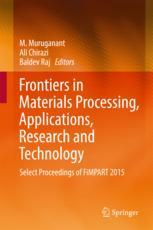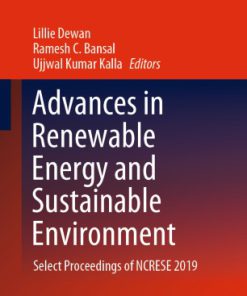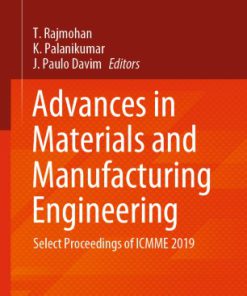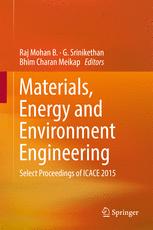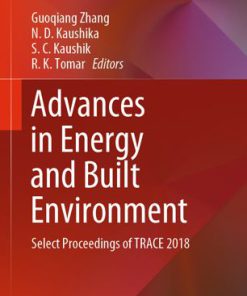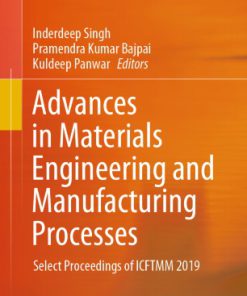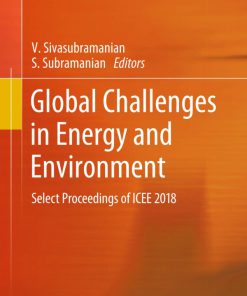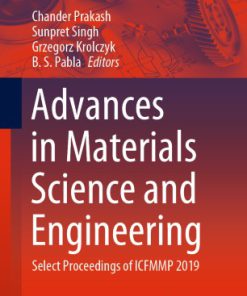Materials Energy and Environment Engineering Select Proceedings of ICACE 2015 1st edition by Raj Mohan 9811026751 9789811026751
$50.00 Original price was: $50.00.$25.00Current price is: $25.00.
Materials Energy and Environment Engineering Select Proceedings of ICACE 2015 1st edition by Raj Mohan B. – Ebook PDF Instant Download/Delivery: 9811026751, 9789811026751
Full download Materials Energy and Environment Engineering Select Proceedings of ICACE 2015 1st edition after payment
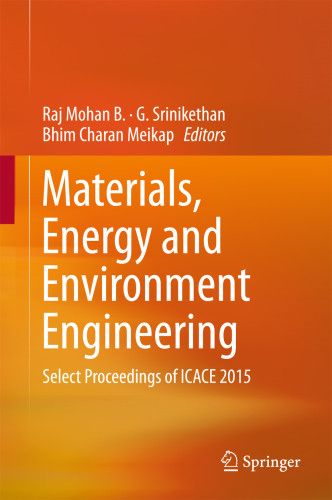
Product details:
ISBN 10: 9811026751
ISBN 13: 9789811026751
Author: Raj Mohan B.
This edited volume comprises the proceedings of ICACE-2015. In the recent past Chemical Engineering as a discipline has been diversifying into several frontier areas and this volume addresses the advances in core Chemical Engineering as well as allied fields. The contents of this volume focus on energy and environmental applications of chemical engineering research and on materials science aspects of chemical engineering. This book will be useful to researchers, students, and professionals, particularly those working on interdisciplinary applications of Chemical Engineering problems.
Materials Energy and Environment Engineering Select Proceedings of ICACE 2015 1st table of contents:
1 Characterization of Citrus Peels for Bioethanol Production
1 Introduction
2 Materials and Methods
2.1 Materials
2.2 Experimental
3 Results and Discussion
3.1 Proximate and Ultimate Analysis
3.2 FTIR Spectroscopy
3.3 Thermal Analysis
4 Conclusion
References
2 Study of Mechanical Properties and Microstructure of Aluminium Alloy Reinforced with TiB2, by in S
1 Introduction
2 Materials and Methods
2.1 Composition of Alloy
2.2 Preparation of Composites by Mixed Salt Route Technique
2.3 Sample Preparation for Optical Microscopy and SEM
2.4 Micro Structural Characterisation
2.5 Wear Testing
2.6 Hardness Testing
2.7 Tensile Testing
3 Results and Discussion
3.1 Microstructure of AA7175-TiB2 Composite
3.2 Wear Behaviour
3.3 Hardness of Composites
3.4 Tensile Behaviour
4 Conclusions
References
3 Development of Bio-Based Epoxide from Plant Oil
1 Introduction
2 Experimental Details
2.1 Materials
2.2 Experimental Procedure
2.3 Chemical and Instrumental Analysis
3 Results and Discussion
3.1 Epoxidation Reactions
3.2 Comparison of Different Acid Catalysts on Epoxide Yield
3.3 Comparison of Different Carboxylic Acids on Epoxide Yield
3.4 FTIR Analysis of Nahor Oil and Products
4 Conclusion
Acknowledgments
References
4 Experimental and FEM Analysis on the Mechanical Properties of Al-8011 Alloy Reinforced with Fly-As
1 Introduction
2 Experimental
2.1 Raw Materials and Their Properties
2.2 Fabrication of Composites
2.3 Brinell Hardness Test
2.4 Tensile and Compression Tests
3 Results and Discussions
3.1 Hardness
3.2 Tensile Strength
3.3 Compression Strength
4 FEM Approach
5 Scanning Electron Microscope Analysis
6 Conclusions
References
5 Effects of Single, Double, Triple and Quadruple Window Glazing of Various Glass Materials on Heat
1 Introduction
2 Experimental Methodology
3 Thermal Analysis
4 Results and Discussions
4.1 Heat Gain in Buildings of Hot and Dry (Ahmedabad) and Temperate (Bangalore) Climatic Regions
4.2 Heat Gain in Buildings of Warm and Humid (Bombay) and Composite (New-Delhi) Climatic Regions
5 Conclusion
References
6 Synthesis of Ruthenium Nanoparticles by Microwave Assisted Solvothermal Technique
1 Introduction
2 Experimental Procedures
2.1 Materials
2.2 Synthesis of Ru Nanoparticles in Pressurized Vial
2.3 Characterisation of Ru Nanoparticles
3 Result and Discussion
3.1 Formation of Ru Nanoparticles
3.2 Effect of PVP/RuCl3 Molar Ratio (MR) on Particle Size
3.3 Effect of MWI Power on Average Size of Ru Nanoparticles
3.4 Stability of Ru Nanoparticle and TEM Analysis
4 Conclusion
References
7 Sonochemical Synthesis of Poly (Styrene-co-Methylmethacrylate)-HNT’s Nanocomposites by Mini-emul
1 Introduction
2 Research Methodology
2.1 Materials
2.2 Mini-emulsion Copolymerization of Poly(Styrene-co-Methylmethacrylate)-HNT’s Nanocomposites
2.3 Polymerization of (Styrene-co-Methylmethacrylate)-HNT’s
3 Characterisation of Nanocomposites
4 Results and Discussions
4.1 Effect of Sonication and Clay Loading on Structure of Nanocomposites
4.2 Studies on Morphology of Nanocomposites
4.3 Effect of HNTs Inclusion on Polymer Structure
4.4 Effect of Clay Loading on Thermal Stability of Nanocomposites
5 Summary/Conclusion
References
8 A Novel Single Step Sonochemical Synthesis of Micro-Nano Size Palladium-Metal Oxides
1 Introduction
2 Experimental
3 Results and Discussions
3.1 X-Ray Diffraction and Size Distribution Analysis
3.2 Microscopy and Elemental Analysis
4 Conclusion
References
9 A Novel Single Step Ultrasound Assisted Synthesis of Nano Size Metal Oxides Metal Carbides and Met
1 Introduction
2 Experimental
3 Results and Discussions
3.1 X-ray Diffraction
3.2 BET Surface Area Analysis
3.3 Size Distribution Analysis
3.4 Scanning Electron Microscopy (SEM) Analysis
4 Conclusion
References
Biosorption and Degradation
10 Denitrification Under Aerobic Condition in Draft Tube Spouted Bed Reactor
1 Introduction
2 Materials and Methodology
2.1 Growth Media Composition
2.2 Analytical Method
3 Experimentation
3.1 Experimental Procedure
4 Results and Discussion
4.1 Effect of Influent Nitrate Concentrations and Dilution Rates on Time to Attain Steady State
4.2 Effect of Nitrate Loading Rate on Removal Rate at Different GAC Loading
4.3 Effect of Ratio of Nitrate Loading Rate to Attached Biomass Weight on Percentage Nitrate Removal
5 Conclusion
Acknowledgments
References
11 Feasibility of Anaerobic Ammonium Oxidation in the Presence of Bicarbonate
1 Introduction
2 Materials and Methods
2.1 Nutrient Media for Anaerobic Ammonia Oxidation
2.2 Biomass
2.3 Batch Reactor Studies
2.4 Kinetic Studies
2.5 Analytical Techniques
3 Results and Discussion
3.1 Feasibility of Anaerobic Ammonium Oxidation Using HCO3− as Electron Acceptor
3.2 Kinetic Studies
4 Conclusions
References
12 Denitration of High Nitrate Bearing Alkaline Waste Using Two Stage Chemical and Biological Proces
1 Introduction
2 Materials and Method
2.1 Chemical Denitration
2.2 Biological Denitrification
3 Result and Discussion
3.1 Chemical Denitration
3.2 Biological Denitrification
4 Conclusion
References
13 Optimization Study of Cadmium Biosorption on Sea Urchin Test: Application of Response Surface Met
1 Introduction
2 Materials and Methods
2.1 Biosorbent Preparation
2.2 Preparation Synthetic Cd(II) Stock Solution
2.3 Biosorption Experiments (Batch Mode)
2.4 Design Variables for Biosorption Study
2.5 Process Optimization
3 Results and Discussion
3.1 Competency of the Model for Cd(II) Removal
3.2 Regression Analysis
3.3 ANOVA for Response Surface Quadratic Model
3.4 Optimization and Confirmation
4 Conclusion
References
14 Optimization of Nickel (II) and Cadmium (II) Biosorption on Brewery Sludge Using Response Surface
1 Introduction
2 Materials and Methods
3 Results and Discussion
4 Conclusion
Acknowledgments
References
15 Biosorption of Copper from Wastewater Using Spirulina Species
1 Introduction
2 Materials and Methods
3 Results and Discussions
3.1 Effect of Contact Time (min)
3.2 Effect of Biosorbent Dosage
3.3 Effect of pH
3.4 Effect of Initial Cu Ion Concentration
3.5 Adsorption Isotherm Study of Cu Metal
3.6 Column Studies
3.7 Experiment on Industrial Sample
4 Summary/Conclusion
References
16 A Study on Simultaneous Photocatalytic Removal of Hexavalent Chromium and Pharmaceutical Contamin
1 Introduction
2 Materials and Methods
3 Results and Discussions
3.1 Characterization of the Catalyst
3.2 Reduction of Hexavalent Chromium
4 Conclusions
Acknowledgments
References
17 Effect of Precursor Salt Solution Concentration on the Size of Silver Nanoparticles Synthesized U
1 Introduction
2 Materials and Methods
2.1 Collection of the Plant Material
2.2 Preparation of the Aqueous Extracts of T. catappa (ALE) and T.Grandis Linn f (TLE) Leaves
2.3 Biosynthesis of AgNPs
3 Results and Discussion
4 Conclusion
References
18 Impact of Hydrochloric Acid on Phase Formation of Titanium Dioxide Nanoparticles
1 Introduction
2 Materials and Methods
3 Results and Discussion
4 Conclusions
References
19 Synthesis and Characterization of Mg Doped CuO Nano Particles by Quick Precipitation Method
1 Introduction
2 Materials and Method
3 Results and Discussion
3.1 XRD Analysis
3.2 FESEM and EDX Analysis
3.3 UV-Vis Analysis
4 Conclusion
References
20 Studies on Process Parameters of Continuous Production of Nickel Nanoparticles Using Spiral Micro
1 Introduction
2 Experimental
2.1 Chemicals
2.2 Experimental Setup and Synthesis
3 Result and Discussion
3.1 Effect of Temperature
3.2 Effect of Surfactant
3.3 Effect of N2H4/Ni2+ Molar Ratio
3.4 SEM Analysis: Nanoparticles Structure
4 Conclusion
References
21 Optimization of Cassava Pulp Pretreatment by Alkaline Hydrogen Peroxide Using Response Surface Me
1 Introduction
2 Materials and Methods
2.1 Materials
2.2 Pretreatment
2.3 Enzyme Hydrolysis
2.4 Fermentation
2.5 Analytical Methods
2.6 Experimental Design
3 Results and Discussion
3.1 Effect of Solid to Liquid Ratio (SLR)
3.2 Model Fitting
3.3 Effect of Process Variables on Reducing Sugar Yield
3.4 Confirmation Experiments
3.5 Spectral Characterization
3.6 Fermentation
4 Conclusions
References
22 Production of Biodiesel from Neem Oil Feedstock Using Bifunctional Catalyst
1 Introduction
2 Materials and Methods
2.1 Preparation of Catalyst
2.2 Method
2.3 Catalyst Recovery
3 Results and Discussion
3.1 Effect of Bifunctional Catalyst
3.2 Effect of Process Time
3.3 Effect of Catalyst
3.4 Effect of Ethanol to Oil Ratio
4 Conclusion
References
23 Influence of Feed Vapour Fraction on the Performance of Direct Methanol Fuel Cell
1 Introduction
2 Experimental Set Up
3 Results and Discussion
3.1 Effect of Feed Vapor Fraction
3.2 Effect of Methanol Concentration
3.3 Comparison with Neat Methanol
4 Conclusion
References
24 Electrocatalytic Borohydride Oxidation by Supported Tungsten Oxide Nanoclusters Towards Direct Bo
1 Introduction
2 Experimental
3 Results and Discussion
4 Conclusion
References
25 Optimal Off-Grid Hybrid Options for Power Generation in Remote Indian Villages: HOMER Application
1 Introduction
2 Methodology and Data Used
3 HOMER Analysis
4 Results and Discussion
4.1 Optimal Hybrid Energy System Architecture
5 Conclusions
References
Websites
26 Experimental Studies on Electricity Production and Removal of Hexavalent Chromium in Microbial Fu
1 Introduction
2 Materials and Methods
2.1 MFC Construction
2.2 MFC Operation
2.3 Measurement and Analysis
3 Results
3.1 Effect of PH
3.2 Effect of Concentration
3.3 Chromium Reduction
4 Discussion
5 Conclusion
References
27 Experimental Studies on Performance of Single Cell PEM Fuel Cell with Various Operating Parameter
1 Introduction
2 Experimental
2.1 Preparation of Catalyst Ink and Fabrication of MEA
2.2 Fuel Cell Tests
3 Results and Discussion
3.1 Effect of Operating Temperature
3.2 Effect of Operating Pressure
3.3 Effect of Anode Humidification Temperature
3.4 Effect of Cathode Humidification Temperature
3.5 Effect of Anode Gas Flow Rate (H2)
3.6 Effect of Cathode Gas Flow Rate (O2)
4 Conclusions
Acknowledgments
References
28 A Study on Utilization of Latex Processing Effluent for Treatment and Energy Recovery in Microbia
1 Introduction
2 Materials and Methods
3 Results and Discussion
3.1 Contaminant Removal
3.2 Energy Recovery
4 Conclusions
Acknowledgments
References
29 Effect of Traditionally Synthesized Carbon Nano Particles as Bio-Fuel Blend on the Engine Perform
1 Introduction
2 Materials and Methodology
2.1 Materials
2.2 Traditional Method of Synthesizing Carbon Nanoparticles
2.3 Materials Characterization of Carbon Nanoparticle
2.4 Blending of Carbon Nanoparticles with Diesel
2.5 Experimental Setup
3 Results and Discussion
3.1 Characterization of Carbon Nanoparticle
3.2 Characterization Variation of Brake Thermal Efficiency (BTE)
3.3 Effect of Smoke Capacity
3.4 Effect of Smoke Capacity
3.5 Variation of NOx Emission
4 Conclusion
Acknowledgments
References
30 Optimization of Chitosan Nanoparticles Synthesis and Its Applications in Fatty Acid Absorption
1 Introduction
2 Materials and Methods
2.1 Preparation of Chitosan Nanoparticles
2.2 Testing of Size of Chitosan Nanoparticles Using Zeta Analyzer
2.3 Testing for Fat Absorption of Chitosan Nanoparticles
3 Results and Discussion
4 Conclusion
References
31 Biosynthesis of Silver Nanoparticles Using Turmeric Extract and Evaluation of Its Anti-Bacterial
1 Introduction
2 Methodology
2.1 Preparation of Extract
2.2 Synthesis of TUAgnps
2.3 Characterization of TUAgnps
2.3.1 UV-Visible Spectroscopic Characterization of TUAgnps
2.3.2 FT-IR Spectroscopic Studies
2.3.3 Particle Size Distribution and Zeta Potential
2.3.4 SEM and EDX Analysis
2.4 Effect of Biosynthesized TUAgnps on the Methylene Blue Reduction and Its Evaluation
2.5 Immobilization of TUAgnps on Cloth and Disk Diffusion Studies
3 Results
3.1 Characterization of TUAgnps
3.1.1 UV-Visible Spectrophotometer
3.1.2 FT-IR Spectroscopic Studies
3.1.3 Particle Size Distribution and Zeta Potential
3.1.4 SEM and EDX Analysis
3.2 Methylene Blue Dye Reduction by TUAgnps and Its Catalytic Activity
3.3 Antimicrobial Activity Studies
4 Conclusions
References
32 Comparison of Metal Oxide Nanomaterials: Humidity Sensor Applications
1 Introduction
2 Experimental Details
3 Results and Discussions
3.1 X-Ray Diffractometer
3.2 Particle Size Analyser
4 Humidity Sensor Application
5 Conclusion
Acknowledgments
References
Pollution Control
People also search for Materials Energy and Environment Engineering Select Proceedings of ICACE 2015 1st:
engineering of soft materials for healthcare energy and environment
advances in energy materials and environment engineering
what is energy and environmental engineering
energy and environmental engineering jobs
energy and environmental engineering salary
Tags: Materials Energy, Environment Engineering, Select Proceedings, Raj Mohan
You may also like…
Engineering
Engineering
Advances in Materials and Manufacturing Engineering: Select Proceedings of ICMME 2019 T. Rajmohan
Engineering
Uncategorized
Advances in Energy and Built Environment Select Proceedings of TRACE 2018 Guoqiang Zhang
Engineering
Global Challenges in Energy and Environment Select Proceedings of ICEE 2018 V Sivasubramanian


